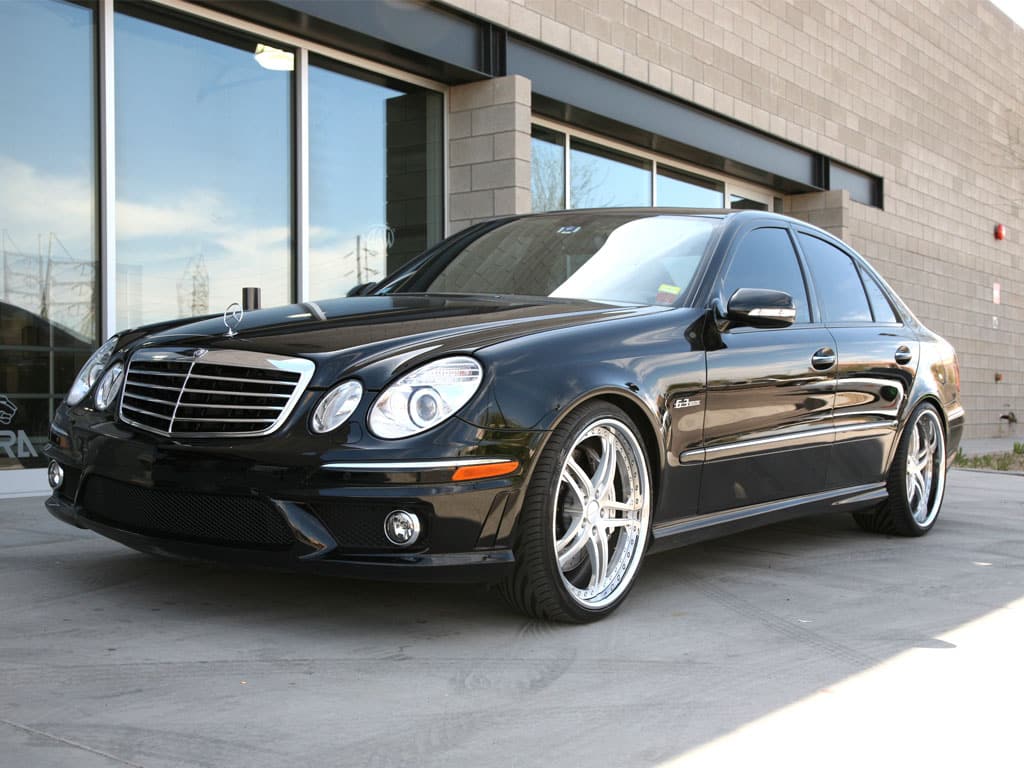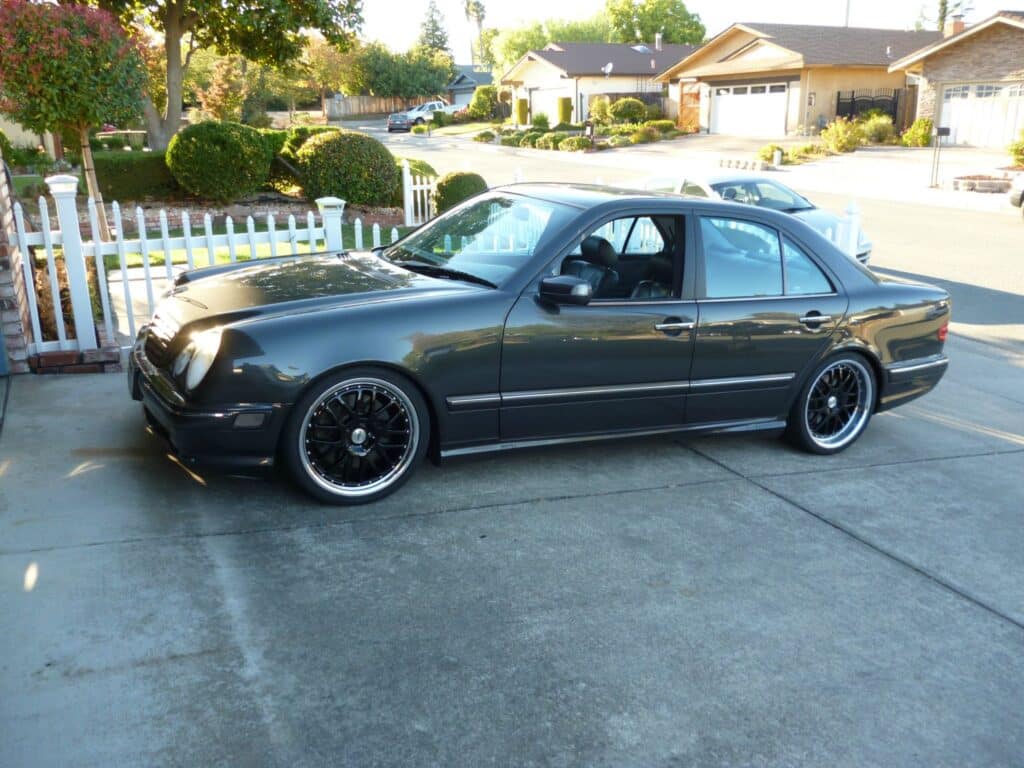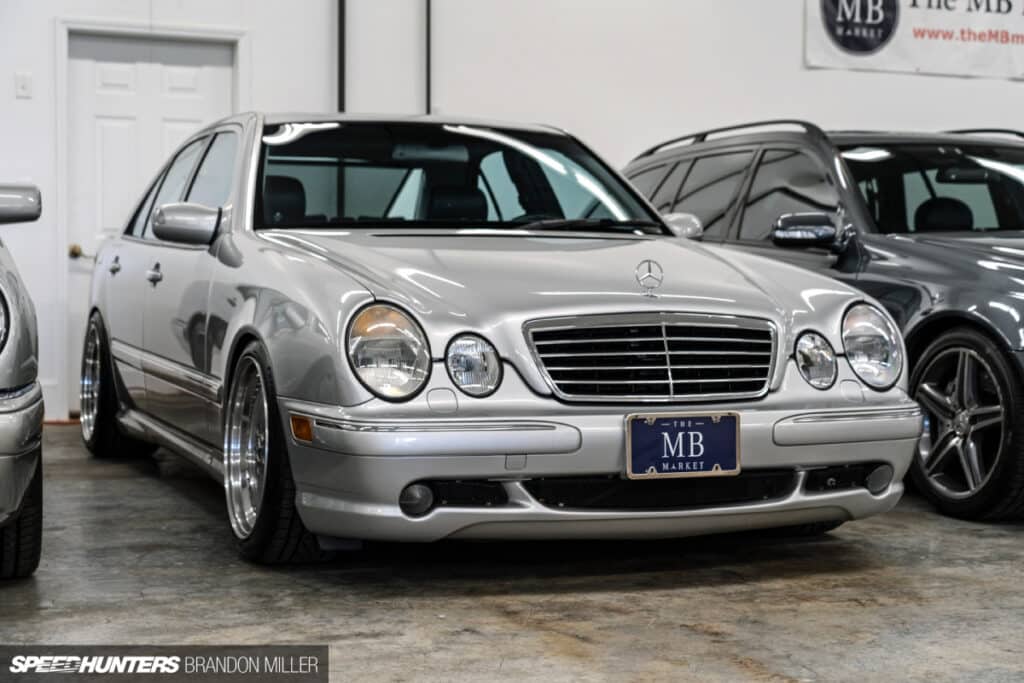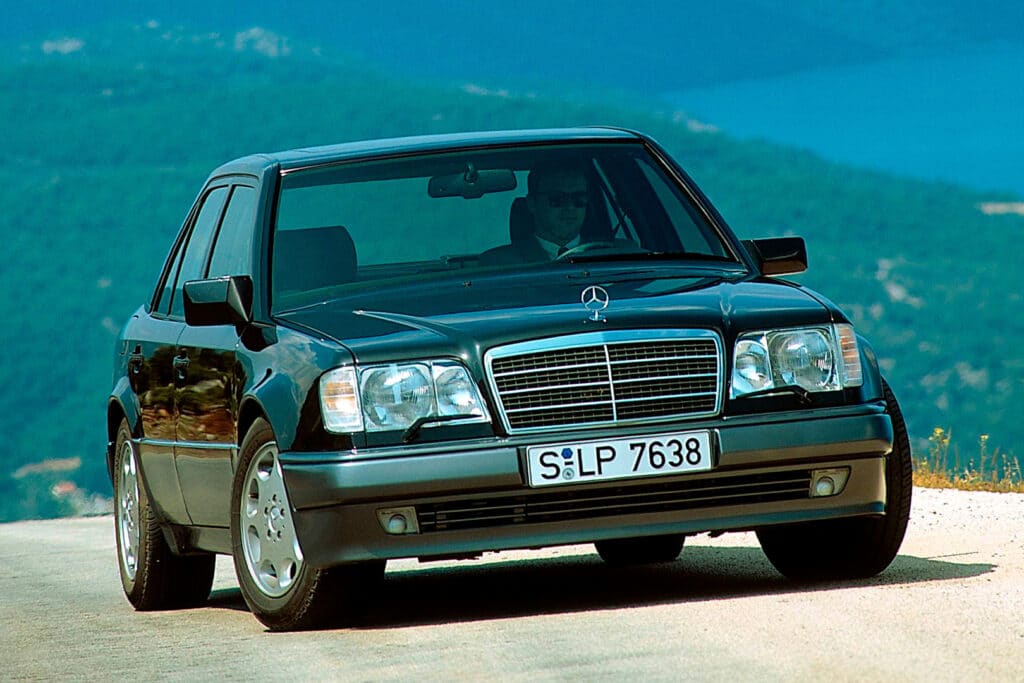The Mercedes-Benz E-Class Sedan, often hailed as the heart of the Mercedes-Benz brand, embodies a blend of luxury, performance, and innovative technology. Its lineage traces back to the W124 introduced in the 1980s, setting new standards for design, safety, and efficiency.
Key Takeaways:
- Evolutionary Progress: From the foundational W124 to the cutting-edge W214, Mercedes-Benz has consistently advanced the engineering and design of their E-Class sedan’s transmissions to improve performance, efficiency, and reliability.
- Fluid Importance: Transmission fluid plays an indispensable role in ensuring smooth gear shifts, cooling the transmission system, and prolonging the unit’s lifespan. It’s not just about quantity but quality, with each E-Class generation having specific fluid formulations.
- Customized Fluids: Mercedes-Benz has always been meticulous about recommending proprietary transmission fluid types, each tailored to the unique requirements of the respective transmission systems, ranging from MB 236.1 to MB 236.17.
- Capacity Specifications: Each generation’s transmission fluid capacity differs, with a range from approximately 8.6 liters (9.1 quarts) in the W124 to around 9 liters (9.5 quarts) in newer models. However, routine fluid changes typically involve replacing only a portion of this total capacity.
- Adherence to Guidelines: Sticking to the manufacturer’s prescribed fluid types and change intervals is paramount. Deviating from these recommendations can compromise performance and risk premature wear.
- Advanced Features: Over the years, Mercedes-Benz introduced numerous transmission innovations, from adaptive shift programs to the 9-speed 9G-TRONIC system, reinforcing the brand’s commitment to driving excellence.
- Regular Maintenance: Beyond fluid changes, regular transmission check-ups are essential. Given the E-Class’s status as a luxury sedan, ensuring its transmission operates flawlessly is central to the vehicle’s overall performance and the driving experience it promises.

Over the years, the E-Class Sedan has undergone numerous evolutions, adapting to the changing demands of the automotive landscape while holding onto its core values of excellence and innovation.
One of the cornerstones ensuring the E-Class Sedan’s impeccable performance and longevity is its transmission system. The transmission serves as the bridge between the engine and the wheels, translating engine power into movement. An essential component of this system is the transmission fluid.
This fluid acts not only as a lubricant, ensuring smooth operation of internal gears but also as a coolant, preventing the transmission from overheating during its intense operations.
Proper maintenance, which includes using the correct type of transmission fluid and adhering to change intervals, is pivotal. It upholds the performance standards set by Mercedes-Benz and ensures that each ride in an E-Class remains as smooth and efficient as intended.
2021-2023 Mercedes-Benz E-class W213 Facelift Transmission Fluid Capacity And Type
The W213 E-Class Facelift, representing the model years from 2021 to 2023, showcases Mercedes-Benz’s continuous commitment to luxury, performance, and innovation.

Given the company’s constant pursuit of advancement, the transmissions during these years witnessed enhancements to improve driving dynamics and efficiency.
| Gearbox | Fluid capacity | Fluid type |
|---|---|---|
| E350 9-speed 725.058 | Total fill: 10.6 quarts (10 liters) | MB 236.17 |
| E450 9-speed 725.045 | Total fill: 10.6 quarts (10 liters) | MB 236.17 |
| E53 AMG 9-speed 725.045 | Total fill: 10.6 quarts (10 liters) | MB 236.17 |
- Please see Product Description regarding the California Proposition 65 Warning
- Designed specifically for use in the Mercedes-Benz 9G-TRONIC NAG3 automatic transmission
- Provides excellent lubricating ability even at low temperatures along with a high, stable viscosity index
- Protects against corrosion and foam formation while providing a high thermal and oxidative stability, and an excellent cooling capacity
- Transmission Specifications:
- 9G-TRONIC: Most variants of the W213 (5th Gen) Facelift came equipped with the 9G-TRONIC automatic transmission. This 9-speed transmission is celebrated for its smooth shifts, fuel efficiency, and ability to deliver power seamlessly. Features like DYNAMIC SELECT allowed drivers to customize the transmission’s behavior, tailoring the driving experience to individual preferences.
- Performance Models: The high-performance AMG variants might feature AMG SPEEDSHIFT transmissions, which offer rapid gear changes and are specifically tuned for a sportier driving experience.
- Suitable Fluid Type and Capacity:
- Fluid Type: Mercedes-Benz recommends using their proprietary MB 236.17 automatic transmission fluid for the 9G-TRONIC transmissions. This fluid is designed to meet the specific requirements of the Mercedes transmissions, ensuring optimal performance and longevity.
- Fluid Capacity: The total transmission fluid capacity for the 9G-TRONIC transmission is approximately 10 liters (10.6 quarts). However, it’s essential to note that during a standard fluid change, not all of the fluid is typically replaced. For a routine service, the amount is closer to 5 liters (5.3 quarts). Always ensure to check fluid levels using the appropriate method and top off if necessary.
2017-2020 Mercedes-Benz E-class Transmission Fluid Capacity And Type
The 5th Gen W213, running from 2017 to 2020, marked a significant step forward for the Mercedes-Benz E-Class Sedan.

Mercedes-Benz is known for its dedication to luxury and performance, and this generation was no exception.
| Gearbox | Fluid capacity | Fluid type |
|---|---|---|
| E300 CAR 9-speed 725.011 | Total fill: 10.6 quarts (10 liters) | MB 236.17 |
| E400 7-speed 722.9 | Total fill: 9.5 quarts (9 liters) | MB 236.15 |
| E400 9-speed 725.045 | Total fill: 10.6 quarts (10 liters) | MB 236.17 |
| E43 AMG 9-speed 725.048 | Total fill: 10.6 quarts (10 liters) | MB 236.17 |
| E63 AMG S 9-speed 725.096 | Total fill: 10.6 quarts (10 liters) | MB 236.17 |
The transmission played a pivotal role in enhancing driving dynamics and ensuring smooth power delivery.
- Please see Product Description regarding the California Proposition 65 Warning
- Designed specifically for use in the Mercedes-Benz 9G-TRONIC NAG3 automatic transmission
- Provides excellent lubricating ability even at low temperatures along with a high, stable viscosity index
- Protects against corrosion and foam formation while providing a high thermal and oxidative stability, and an excellent cooling capacity
- Transmission Distinctions:
- Introduction of the 9G-TRONIC: One of the hallmarks of this generation was the widespread adoption of the 9G-TRONIC automatic transmission across many E-Class variants. This 9-speed automatic set new standards in terms of efficiency, shift comfort, and speed. Its broader spread of gears ensured the engine operated closer to its optimal speed range, enhancing fuel efficiency and driving dynamics.
- Performance Models: For those seeking greater thrills, the AMG models during this period were equipped with AMG-tuned variants of transmissions, often denoted as AMG SPEEDSHIFT, providing more aggressive and rapid gear changes.
- Prescribed Fluid Type and Capacity:
- Fluid Type: For the 9G-TRONIC transmission, Mercedes-Benz’s specific recommendation remains the MB 236.15 or MB 236.17 automatic transmission fluid. This fluid is specially formulated to meet the demands of their sophisticated transmissions.
- Fluid Capacity: The total capacity for the 9G-TRONIC transmission is around 9 liters (9.5 quarts). However, during routine fluid change services, not all the fluid will be replaced, typically involving a refill of approximately 5 liters (5.3 quarts). Always ensure the fluid level is checked accurately and topped off as necessary.
It’s always paramount to ensure that your E-Class Sedan gets the care and attention it deserves.
2014-2016 Mercedes-Benz E-class W212 Facelift Transmission Fluid Capacity
The facelifted 4th generation of the Mercedes-Benz E-Class, covering model years from 2014 to 2016, further refined the luxurious attributes of the W212 lineage.

With enhancements in aesthetics, technology, and performance, the transmission was central to the sedan’s driving excellence.
| Gearbox | Fluid capacity | Fluid type |
|---|---|---|
| E250 CAR 7-speed 722.90 | Total fill: 9.5 quarts (9 liters) | MB 236.15 |
| E350 7-speed 722.96 | Total fill: 10.2 quarts (9.6 liters) | MB 236.15 |
| E400 7-speed 724.206 | Total fill: 9.5 quarts (9 liters) | MB 236.15 |
| E550 7-speed 722.909 | Total fill: 9.5 quarts (9 liters) | MB 236.15 |
| E63 AMG 7-speed 722.97 | Total fill: 8.2 quarts (7.8 liters) | MB 236.15 |
| E63 AMG S 7-speed 722.97 | Total fill: 8.2 quarts (7.8 liters) | MB 236.15 |
- Transmission Features:
- 7G-TRONIC Plus: The primary transmission for many E-Class variants during this period was the 7G-TRONIC Plus. This 7-speed automatic transmission offered a harmonious blend of efficiency, dynamic response, and smooth shifting. The “Plus” variant of this transmission was known for its optimized torque converter lock-up, reduced noise, and improved gear-changing properties.
- Eco Start/Stop Function: Integrated with the 7G-TRONIC Plus, the ECO start/stop function played a role in enhancing fuel efficiency by automatically turning off the engine at stops and instantly restarting when the driver intends to move.
- Suggested Fluid Type and Volume:
- Fluid Type: Mercedes-Benz specified the use of MB 236.15 or equivalent transmission fluid for the 7G-TRONIC Plus. This proprietary fluid was designed to satisfy the operational demands of their advanced transmission, ensuring both performance and longevity.
- Fluid Capacity: The full transmission fluid capacity for the 7G-TRONIC Plus sits at approximately 9 liters (9.5 quarts). However, during a standard fluid change procedure, not all of the old fluid may be removed. Therefore, a typical service refill may be closer to 5 liters (5.3 quarts). It’s vital to check the fluid levels using the recommended methods and adjust if needed.
Ensuring that your Mercedes-Benz E-Class receives the right care, especially in terms of transmission maintenance, is crucial for its longevity and optimal performance. Always refer to the vehicle’s user manual or seek guidance from certified professionals when considering fluid changes.
2010-2013 Mercedes-Benz E-class W212 Transmission Fluid Capacity
The 4th generation of the Mercedes-Benz E-Class, particularly the W212 models spanning from 2010 to 2013, set new benchmarks in luxury sedan performance and sophistication.

The transmission, as a pivotal component, played a key role in elevating the driving experience.
| Gearbox | Fluid capacity | Fluid type |
|---|---|---|
| E350 7-speed 722.906 with code A89 | Total fill: 9.5 quarts (9 liters) | MB 236.15 |
| E350 7-speed 722.906 without code A89 | Total fill: 9.5 quarts (9 liters) | MB 236.14 |
| E550 7-speed 722.961 with code A89 | Total fill: 10.2 quarts (9.65 liters) | MB 236.15 |
| E550 7-speed 722.961 without code A89 | Total fill: 10.2 quarts (9.65 liters) | MB 236.14 |
| E63 AMG 7-speed 722.9 without code A89 | Total fill: 9.5 quarts (9 liters) | MB 236.14 |
| E63 AMG 7-speed 722.9 with code A89 | Total fill: 9.5 quarts (9 liters) | MB 236.15 |
- Versatile Use: Ideal for Mercedes Benz Transmission models requiring ATF 134, 236.14 or 236.12 types.
- Precise Packaging: Supplied in a 32 Fl Oz bottle, equivalent to 946.24 milliliters, ensuring accurate measurement for your needs.
- Quality Assurance: Manufactured to meet the highest standards of performance and durability, ensuring a smooth transmission operation.
- Transmission Specifics:
- 7G-TRONIC: Introduced earlier but widely utilized in this generation, the 7G-TRONIC was Mercedes-Benz’s hallmark 7-speed automatic transmission. Designed for efficiency and swift response, it provided a seamless shifting experience complemented by its broad spread of ratios. This transmission was equipped in most of the E-Class variants during this period.
- Adaptive Shift Programs: The transmission boasts adaptive shift programs, which automatically adjust to the driving style of the user. Whether it’s a spirited drive or a relaxed cruise, the system intelligently chooses the appropriate shifting strategy.
- Advised Fluid Type and Capacity:
- Fluid Type: For the 7G-TRONIC transmission in this generation, Mercedes-Benz recommended the use of MB 236.15 or MB 236.14 transmission fluids. Crafted to meet the specific needs of their transmission design, this fluid ensures durability, efficient operation, and peak performance.
- Fluid Capacity: The total transmission fluid capacity for the 7G-TRONIC is about 9 liters (9.5 quarts). Nevertheless, during a routine fluid change, not all of the old fluid might be extracted.
Staying informed about the intricacies of your vehicle and adhering to the manufacturer’s guidelines can significantly contribute to the longevity and performance of your Mercedes-Benz E-Class. For any transmission concerns or maintenance needs, always consult your vehicle’s manual or seek advice from certified Mercedes-Benz technicians.
2007-2009 Mercedes-Benz E-class W211 Facelift Transmission Fluid Capacity
The facelifted W211 from 2007 to 2009 not only introduced aesthetic refinements but also significant technical upgrades, especially in the transmission department.

This was a period when Mercedes-Benz started integrating more advanced tech features to enhance the driving experience and operational efficiency of their vehicles.
| Gearbox | Fluid capacity | Fluid type |
|---|---|---|
| E320 7-speed 722.9 | Total fill: 9.7 quarts (9.2 liters) | MB 236.14 |
| E350 7-speed 722.9 | Total fill: 9.7 quarts (9.2 liters) | MB 236.14 |
| E550 5-speed 722.6 | Total fill: 8.6 quarts (8.1 liters) | MB 236.14 |
| E63 AMG 7-speed 722.9 | Total fill: 9.3 quarts (8.8 liters) | MB 236.14 |
- Versatile Use: Ideal for Mercedes Benz Transmission models requiring ATF 134, 236.14 or 236.12 types.
- Precise Packaging: Supplied in a 32 Fl Oz bottle, equivalent to 946.24 milliliters, ensuring accurate measurement for your needs.
- Quality Assurance: Manufactured to meet the highest standards of performance and durability, ensuring a smooth transmission operation.
- Transmission Enhancements:
- 7G-TRONIC Introduction: While the 7G-TRONIC transmission had already made its debut in other Mercedes-Benz models, the W211 facelifted versions embraced this advanced 7-speed automatic transmission. Offering improved fuel efficiency, reduced emission levels, and a more dynamic driving experience, it was a noticeable upgrade from the previous 5-speed transmissions.
- Shift Paddles: Some models equipped with the 7G-TRONIC transmission now came with steering wheel-mounted shift paddles, providing the driver with the option for manual gear selection and a sportier driving experience.
- SpeedShift Function: This function, integrated into certain AMG models, allowed for quicker gear changes and enhanced the overall sporty feel of the vehicle.
- Ideal Fluid Type and Capacity:
- Fluid Type: Mercedes-Benz recommended the use of their proprietary MB 236.14 automatic transmission fluid for the 7G-TRONIC transmission. This fluid was formulated specifically for the extended drain intervals and unique requirements of these advanced transmissions.
- Fluid Capacity: For the 7G-TRONIC transmission, the total fluid capacity stands at approximately 9.2 liters (9.7 quarts). However, during a routine fluid change, the entire capacity might not be fully replaced. A typical service refill could be around 5 liters (5.3 quarts). Following a fluid change, it’s crucial to check the levels and adjust to the recommended mark.
Maintaining your Mercedes-Benz E-Class with the appropriate transmission fluid is paramount for its long-term performance and efficiency.
2003-2006 Mercedes-Benz E-class W211 Transmission Fluid Capacity And Type
The W211 generation of the Mercedes-Benz E-Class Sedan, spanning from 2003 to 2006, marked a significant leap forward in terms of both design and technology.

With this generation, Mercedes-Benz further solidified the E-Class’s reputation as a benchmark in the executive saloon segment. The transmission, as one of the core components, received noteworthy enhancements.
| Gearbox | Fluid capacity | Fluid type |
|---|---|---|
| E320 5-speed 722.6 | Total fill: 7.9 quarts (7.5 liters) | MB 236.14 |
| E500 7-speed 722.9 | Total fill: 9.3 quarts (8.8 liters) | MB 236.14 |
| E500 5-speed 722.6 | Total fill: 7.9 quarts (7.5 liters) | MB 236.14 |
| E55 AMG 5-speed 722.6 | Total fill: 7.9 quarts (7.5 liters) | MB 236.14 |
- Key Transmission Changes:
- 5G-TRONIC Introduction: The earlier years of this generation mainly saw the 5-speed automatic transmission, known as the 5G-TRONIC. It was known for its smooth operation and durability. Later in this generation, Mercedes started introducing the 7G-TRONIC in some higher-end models and variants, a move that would become more pronounced in the subsequent facelift.
- Tiptronic Function: The W211 models equipped with the 5G-TRONIC often featured Tiptronic manual shift mode, which allowed drivers to manually select gears if desired, providing a blend of automatic convenience with manual control.
- Optimized Efficiency: With the W211’s transmission, Mercedes-Benz focused on optimizing gear ratios and electronic controls to improve fuel efficiency and reduce emissions.
- Recommended Fluid Type and Capacity:
- Fluid Type: For the 5G-TRONIC transmission, Mercedes-Benz recommended the use of their proprietary MB 236.14 automatic transmission fluid. This special formulation was tailored to meet the specific operational requirements of the 5G-TRONIC transmission.
- Fluid Capacity: The 5G-TRONIC transmission’s total fluid capacity is approximately 7.5 liters (7.9 quarts). However, during a typical fluid change procedure, the entirety of this capacity might not be exchanged. A general service refill might be in the ballpark of 4 to 5 liters (4.2 to 5.3 quarts).
For any Mercedes-Benz E-Class owner, it is essential to stick to the prescribed guidelines when considering transmission fluid maintenance. By doing so, you ensure the longevity and top-notch performance of your vehicle.
2000-2002 Mercedes-Benz E-class W210 Facelift Transmission Fluid Capacity And Type
The facelifted W210 generation, covering the years from 2000 to 2002, saw Mercedes-Benz refining and further polishing the E-Class’s already impressive reputation. A refreshed exterior design, upgraded tech features, and improved safety measures highlighted this era.

The transmission, a pivotal component in any car’s operation, also experienced its share of enhancements during this period.
| Gearbox | Fluid capacity | Fluid type |
|---|---|---|
| E320 5-speed 722.6 | Total fill: 9.1 quarts (8.6 liters) | MB 236.14 |
| E430 5-speed 722.6 RWD | Total fill: 9.1 quarts (8.6 liters) | MB 236.14 |
| E430 5-speed 722.6 4MATIC | Total fill: 7.9 quarts (7.5 liters) | MB 236.14 |
- Transmission Details:
- 5G-TRONIC Transition: One of the major shifts in this era was the broader introduction of the 5-speed automatic transmission, dubbed the 5G-TRONIC. This transmission was recognized for its improved smoothness and reliability compared to its predecessors.
- Electronic Management: With the introduction of the 5G-TRONIC, Mercedes-Benz also brought in more advanced electronic management systems for the transmission, providing quicker and smoother gear shifts.
- Winter and Sport Modes: The transmission featured driving modes such as Winter (W) and Sport (S), allowing drivers to adapt the car’s driving behavior according to road conditions or personal preferences.
- Suitable Fluid Type and Volume:
- Fluid Type: Mercedes-Benz recommended their proprietary MB 236.14 automatic transmission fluid for the 5G-TRONIC. This specific formulation ensures that the transmission operates smoothly while protecting its internal components.
- Fluid Volume: The total fluid capacity for the 5G-TRONIC transmission in the W210 (2nd Gen) Facelift models is approximately 8.6 liters (9.1 quarts). However, during a standard fluid change, this entire capacity might not be replaced.
Maintaining the transmission fluid at the recommended levels and using the specified type is crucial to ensure the longevity and optimal performance of the W210 Mercedes-Benz E-Class. For precise guidance, always refer to the vehicle’s owner manual or consult with an expert Mercedes-Benz technician.
1996-1999 Mercedes-Benz E-class W210 Transmission Fluid Capacity And Type
As the dawn of the new millennium approached, Mercedes-Benz introduced the W210 generation, marking a paradigm shift in design and technology. The W210 E-Class, from 1996 to 1999, showcased the brand’s commitment to blending luxury with advanced engineering.

The transmission, an essential cog in the symphony of automotive motion, played a vital role in bringing this vision to life.
| Gearbox | Fluid capacity | Fluid type |
|---|---|---|
| E300 CAR 5-speed 722.6 | Total fill: 7.9 quarts (7.5 liters) | MB 236.14 |
| E320 5-speed 722.6 | Total fill: 7.9 quarts (7.5 liters) | MB 236.14 |
| E420 5-speed 722.6 | Total fill: 9.1 quarts (8.6 liters) | MB 236.14 |
- Transmission Features:
- Introduction of 5G-TRONIC: This generation saw the debut of the 5G-TRONIC automatic transmission in some models, which later became a mainstay in several Mercedes-Benz vehicles. Known for its durability and five-speed configuration, this transmission allowed for smoother transitions between gears and better overall driving dynamics.
- Adaptive Transmission Logic: The system adapted to the individual driving style of its operator, ensuring a more tailored driving experience. Whether one leaned toward aggressive accelerations or a more relaxed cruise, the transmission adjusted accordingly.
- Economy and Sport Modes: These modes allowed drivers to toggle between different driving styles. Economy mode prioritized smoother shifts at lower RPMs, while Sport mode held gears longer for a more dynamic response.
- Suggested Fluid Type and Capacity:
- Fluid Type: The recommended transmission fluid for the early W210 models was typically the MB 236.14 automatic transmission fluid. Mercedes-Benz engineers formulated this fluid to meet the specific needs of the 5G-TRONIC, ensuring smooth operations and reduced wear.
- Fluid Volume: The transmission system of the W210 (2nd Gen) models had a total capacity of about 7.5 liters (7.9 quarts). During routine fluid changes, however, not all of this fluid is usually replaced. For a standard service refill, around 4 to 5 liters (4.2 to 5.3 quarts) would be typical. Post-fluid change, it’s essential to verify and adjust fluid levels per the manufacturer’s guidelines.
Mercedes-Benz E-class W124 Transmission Fluid Capacity And Type
The W124 E-Class, running from 1994 to 1995, holds a revered place in the pantheon of Mercedes-Benz’s storied history. As the vanguard of the E-Class lineage, these vehicles blended refined design with impeccable engineering, setting a benchmark for subsequent generations.

Central to this achievement was its transmission, a marvel of mechanical precision that played a crucial role in the vehicle’s exceptional drive quality.
| Gearbox | Fluid capacity | Fluid type |
|---|---|---|
| E320 4-speed 722.3 | Total fill: 7.7 quarts (7.3 liters) Initial fill: 6.6 quarts (6.2 liters) | Dexron III ATF |
| E420 4-speed 722.3 | Total fill: 9.1 quarts (8.6 liters) Initial fill: 8.1 quarts (7.7 liters) | Dexron III ATF |
| E500 4-speed 722.3 | Total fill: 9.1 quarts (8.6 liters) Initial fill: 8.1 quarts (7.7 liters) | Dexron III ATF |
- Introduction to the E-Class Sedan’s Transmission:
- 4G-TRONIC Transmission: The W124 primarily featured the 4-speed automatic transmission. This four-speed unit was celebrated for its robust construction and reliability. It effortlessly channeled the engine’s power to the wheels, ensuring a seamless and refined driving experience characteristic of Mercedes-Benz.
- Hydraulic System: Relying on a hydraulic system, the transmission utilized fluid pressure to control gear shifts, making transitions between gears smooth and unnoticeable.
- Mechanical Durability: The transmission’s design placed a premium on longevity, with many units achieving significant mileage with minimal maintenance, a testament to Mercedes-Benz’s commitment to lasting quality.
- Prescribed Fluid Type and Volume:
- Fluid Type: The recommended transmission fluid for the W124’s 4G-TRONIC was typically the Dexron III automatic transmission fluid. This particular fluid was chosen due to its ideal viscosity and protective qualities, ensuring smooth shifting and reduced component wear.
- Fluid Volume: For the W124’s transmission system, the total fluid capacity was approximately 8.6 liters (9.1 quarts).
For owners of the W124, or those fortunate enough to encounter one, these vehicles represent a masterclass in automotive craftsmanship. Proper attention to transmission maintenance, especially fluid care, will ensure these classics continue to deliver unparalleled driving satisfaction.
Understanding the Role of Transmission Fluid
The transmission is a marvel of mechanical engineering, allowing vehicles to traverse terrains, shift speeds, and deliver power effectively. At its core, the transmission is a complex system of gears, shafts, and torque converters that work in harmony to transfer power from the engine to the drive wheels.
This transfer of power enables a vehicle to accelerate, decelerate, and maintain cruising speeds, providing drivers with a smooth and responsive driving experience.
Transmission fluid plays a pivotal role in ensuring that this intricate machinery operates seamlessly:
- Lubrication: One of the primary functions of transmission fluid is to lubricate the moving parts within the transmission. The fluid creates a protective barrier between metal surfaces, minimizing wear and reducing the risk of premature parts failure. Without proper lubrication, the metal components would grind against one another, leading to increased friction, wear, and potential damage.
- Cooling: Transmissions generate a considerable amount of heat during operation, especially under heavy loads or when frequently shifting gears. Transmission fluid acts as a coolant, dissipating this heat and maintaining an optimal operating temperature. By preventing overheating, the fluid ensures that the transmission functions efficiently and extends its lifespan.
- Assisting in Gear Shifts: Modern automatic transmissions rely on hydraulic pressure, provided by the transmission fluid, to change gears. The fluid flows through the transmission’s valve body, activating various valves and solenoids that control gear shifts. The fluid’s properties—its viscosity and pressure—determine how smoothly and quickly these gear changes occur. Using the correct fluid type ensures that gear shifts are efficient, timely, and free from jerks or delays.
Proper transmission fluid is essential for maintaining the smooth operation and longevity of vehicle components. It’s what delivers the high-end driving experience that luxury vehicles like the Mercedes-Benz E-Class Sedan are designed for.
Selecting the Right Transmission Fluid
Transmission fluid is not a one-size-fits-all solution. Each vehicle, given its unique engineering and design, has specific requirements when it comes to the type of fluid that should be used.
Mercedes-Benz, with its longstanding reputation for excellence and precision, has precise guidelines when it comes to selecting the right transmission fluid for its vehicles, including the E-Class Sedan.
- The Significance of Mercedes-Benz’s Fluid Recommendations:
- Optimized Performance: Mercedes-Benz engineers spend countless hours researching and testing to determine the best fluid type for each model. This ensures that the transmission operates at peak efficiency, translating to smooth gear shifts, responsive acceleration, and an overall superior driving experience.
- Prolonged Transmission Lifespan: Using the recommended fluid ensures that the internal components of the transmission are adequately lubricated and cooled. This reduces wear and tear, extending the lifespan of the transmission.
- Warranty and Service Considerations: Adhering to manufacturer’s fluid recommendations often plays a role in warranty claims. Using the recommended fluid ensures that any transmission-related issues are covered under Mercedes-Benz’s warranty terms.
- Dangers Associated with Incorrect or Non-Recommended Fluids:
- Compromised Performance: Using an incorrect fluid can alter transmission behavior. Drivers might notice sluggish gear shifts, unresponsive acceleration, or even jerky movements. This not only diminishes driving pleasure but can also be a precursor to more significant issues.
- Increased Wear and Potential Damage: Non-recommended fluids might not provide the same level of lubrication or cooling as the prescribed type. This can lead to increased friction between components, resulting in premature wear and potential damage.
- Voided Warranty: Using a non-recommended fluid might void the vehicle’s warranty, especially if it leads to transmission-related issues. This means potential high-cost repairs would come out of the vehicle owner’s pocket.
Transmission Fluid Change Intervals
Ensuring your vehicle runs optimally involves not just selecting the right transmission fluid, but also adhering to recommended change intervals. For a vehicle as meticulously engineered as the Mercedes-Benz E-Class Sedan, regular transmission fluid checks and changes are vital to preserve its performance and longevity.
- The Initial Recommended Timing for Fluid Change:
- For many Mercedes-Benz vehicles, the initial transmission fluid change is typically recommended between 40,000 to 50,000 miles. However, it’s essential to consult the specific owner’s manual of your E-Class model year, as this interval can vary based on the generation and specific transmission used.
- Regular Change Intervals and Their Importance:
- After the initial change, it’s generally advised to replace the transmission fluid every 60,000 to 80,000 miles. Regular changes help:
- Maintain Optimal Performance: Fresh fluid ensures that the transmission continues to shift gears smoothly and efficiently.
- Prolong Transmission Life: Over time, transmission fluid can degrade and collect contaminants. Replacing old fluid helps prevent undue wear and tear.
- Prevent Potential Issues: Regular fluid changes can help identify potential transmission issues before they become major problems.
- After the initial change, it’s generally advised to replace the transmission fluid every 60,000 to 80,000 miles. Regular changes help:
- Factors Influencing the Change Intervals:
- Driving Habits: Aggressive driving, frequent stop-and-go traffic, or regular towing can put additional strain on the transmission, requiring more frequent fluid changes.
- Environmental Conditions: Driving in extremely hot or cold conditions can affect transmission fluid’s efficiency and might necessitate earlier changes.
- Model Variations: Some high-performance E-Class models or those with specific transmissions might have unique fluid change recommendations.
- Quality of Fluid Used: Premium-quality fluids tend to last longer and provide better protection, potentially extending change intervals.
In summary, while there are general guidelines for transmission fluid changes, the best source of information remains the vehicle’s manual.
Following the recommended intervals ensures that the E-Class Sedan’s transmission remains in peak condition, reflecting the luxury and performance the model is renowned for.
Last update on 2025-12-23 / Affiliate links / Images from Amazon Product Advertising API

















